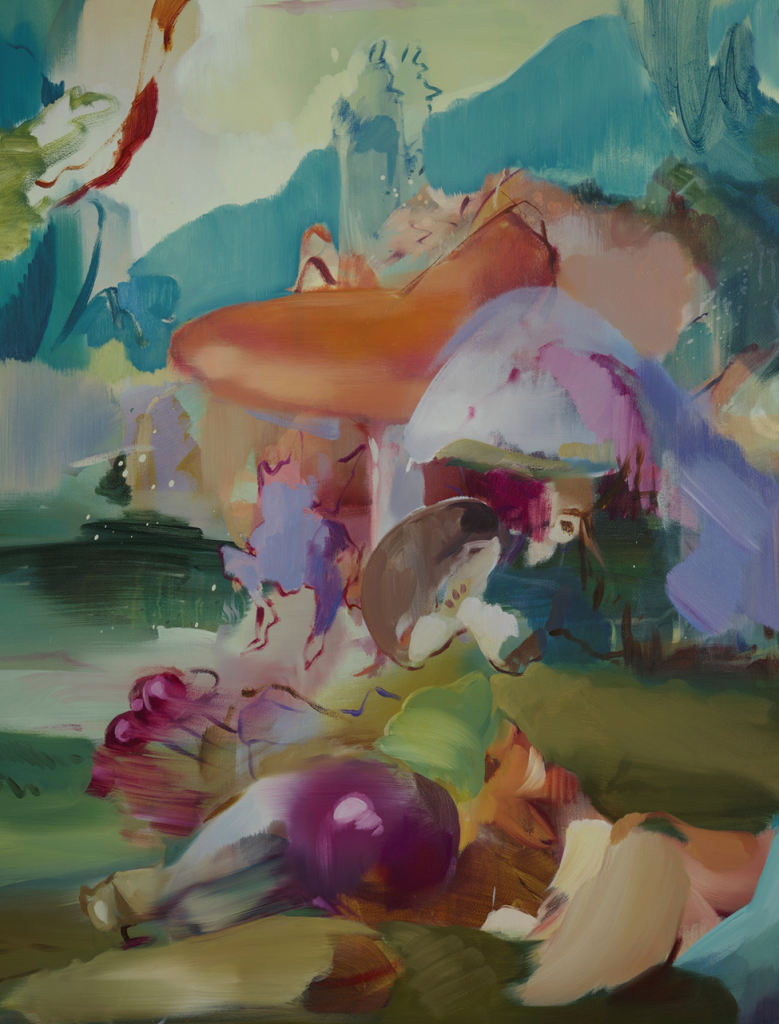
What draws artists and audiences back to the Baroque now, in a century shaped by speed and fracture? Perhaps it is the recognition of kinship. The seventeenth century was also an age of cataclysm and wonder — continents mapped, the cosmos recalculated, science expanding perception. The Baroque arose amid fracture: religious schisms, shifting empires, faith and politics entangled. Art became theatrical, constructed to move the spirit through light, motion, and sensation.
That theatricality was never confined to Europe. As empires spread, Baroque forms traveled across the Americas and Asia, along trade routes. The Baroque’s visual language of excess and light became global, shaping how belief and power were staged, how ornament and faith intertwined. It was an art of transformation, where beauty remained an ideal, revealed through turbulence rather than calm. The viewer was asked to enter, to be moved.

Flora Yukhnovich’s Four Seasons at the Frick Collection draws on that sensibility. Installed in the museum’s Cabinet Gallery, the site-specific work consists of oil on mural cloth fitted seamlessly to the room’s architecture. The paintings wrap around the walls, surrounding the viewer in a continuous field of color and motion. The installation reclaims the space that once housed the Boucher Room, unfolding there as an atmospheric and encompassing world. Yukhnovich takes as her point of departure, François Boucher’s The Four Seasons (1755), painted for Madame de Pompadour. In Boucher’s series, the customary depictions of seasonal labor give way to scenes of intimacy and leisure — figures at ease within luminous landscapes, where gesture and atmosphere suggest luxury and desire. The rhythm of nature becomes a rhythm of the human body.


In Yukhnovich’s world, the lovers and pastoral figures of Boucher’s scenes have dispersed. Yet, their sensuality remains, diffused through gesture and color. What was once embodied in skin and fabric becomes abstracted into tone, rhythm, and breath. The room seems to breathe with its own weather — painted air swirling and luminous, full of pleasure, restlessness, and yearning. The mural captures each season through its pulse: spring opening into radiance, summer thickening into heat, autumn glowing in fruit and dusk, winter moving upwards toward stillness.
The transitions are seamless, one dissolving into the next like light moving across a day: autumn into summer, summer into spring, until winter, framed between two tall windows, pauses the flow in hush of cool light. The frosted window panes filter soft, indirect light from the Garden Court. Within this difused light, Winter unfolds as a vortex of cool blues, violets, and pearlescent whites. The pale moon above the center anchors the composition, its radiance dissolving into vaporous clouds and snowy forms. Around it, traces of vegetal and organic shapes, perhaps fur or folded fabric, appear and fade. The paint seems to move, conjuring both the chill and luminosity of winter air.


22 3/8 x 28 3/4 in. (56.8 x 73 cm) The Frick Collection, New York Photo: Joseph Coscia Jr.
Yukhnovich’s brushwork is deliberate and sensuous, its thinness exposed, revealing the movement of the hand in the instant of decision. Thin washes open into translucent veils; faint ridges and dry strokes trace the pace of the brush across the surface. The paint carries transparency, allowing light to circulate within the field. The palette—greens, violets, ochres, pinks—recalls Boucher’s delicacy but expands it into layered atmospheres that hover and drift. Color behaves like weather, charged with energy and memory of seasons past. Shapes flicker — a fruit, a fold of fabric, an animal’s flank, a hint of a reclining figure —then recede. The paint holds exuberance and fragility together, its sensuality bound to the passing of time.

Each season is bordered by fabric frames in a deep, saturated red, rich in texture and reminiscent of tapestries and eighteenth-century interiors. Their geometry offers a measured counterpoint to the mural’s flow: fixed, rectilinear bands that steady the surrounding motion without constraining it. The red absorbs and reflects the filtered daylight from the Garden Court windows, heightening the mural’s luminosity and depth. Together, the painted atmosphere and architectural structure form a balanced field—fluid imagery held within clear geometry, the seasons unfolding in perfect sync with the room’s proportions and contained light.
As your gaze follows these movements, another awareness settles in, the one Walter Benjamin saw at the core of the Baroque imagination: beauty shadowed by its own passing. Each flare of color already contains its fading. What feels radiant also feels temporary, as if the painting itself were exhaling. The act of seeing becomes temporal, pleasure and loss held in the same breath.
Flora Yukhnovich’s Four Seasons at the Frick Collection
runs through March 9, 2026
About the writer: Etty Yaniv is a Brooklyn-based artist, writer, curator, and founder of Art Spiel. She works in installation, painting, and mixed media, and has shown her art in exhibitions across the United States and abroad. Since 2018 she has published interviews and reviews through Art Spiel, often focusing on underrecognized voices and smaller venues. The publication also serves as a platform for writers, supporting new voices in writing about art. Yaniv’s studio practice is central to her work, and she is also active in the ongoing conversation around contemporary art. More about her art can be found at ettyyanivstudio.com and on Instagram @etty.yaniv